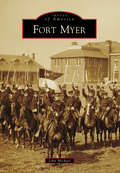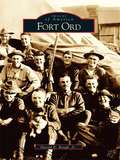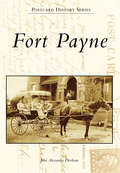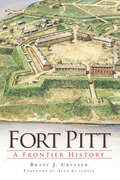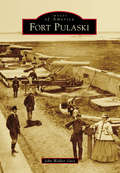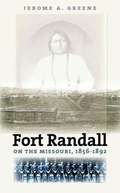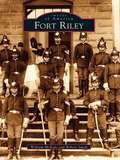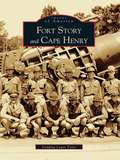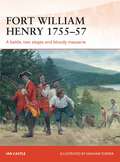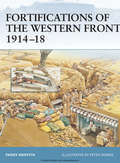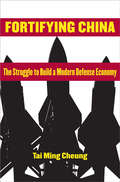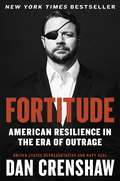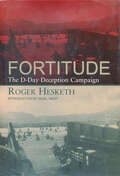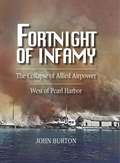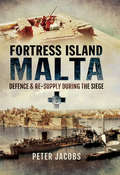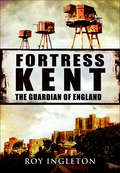- Table View
- List View
Fort Myer (Images of America)
by John MichaelOverlooking Washington, DC, Fort Myer holds a commanding view of America's capital. Built in 1863 from the Custis-Lee estate, one of 70 defensive Civil War fortifications of the capital, this historic US Army post was known as Fort Whipple. As the war ended and reconciliation began, only this fort remained and was later renamed to honor the US Army's first signal officer, Brig. Gen. Albert J. Myer. These acres of Arlington Heights are distinguished by unique events, including the beginnings of military aviation, the Army Cavalry showcase, "The Three Sisters," and the National Weather Bureau. During World War I, Army officers trained here to fight "Over there," and today two units call Fort Myer home: the Army Band ("Pershing's Own," since 1942) and the 3rd Infantry ("The Old Guard," since 1948). Photographs and text present the evolution of this national landmark in its first 100 years, including its buildings, people, and events.
Fort Ord (Images of America)
by Harold E. Raugh Jr.From its establishment during World War I to its closure at the end of the Cold War, the Army installation best known as Fort Ord made a significant contribution to our national defense. Founded as a training area for Presidio of Monterey troops in 1917, Fort Ord covered more than 28,000 acres near the city of Monterey in its heyday. The local topography made it ideal as an infantry training center, and this was its primary mission throughout much of the 20th century. Most recently, Fort Ord was home to the 7th Infantry Division (Light), which was inactivated in 1993. In September 1994, Fort Ord closed its gates and became a part of military history.
Fort Payne (Postcard History)
by John Alexander Dersham Collins KirbyFort Payne was named for the US Army stockade at the Native American village of Willstown, where Cherokee scholar Sequoyah developed his famous alphabet in the 1820s. Following the Cherokee Removal of 1838, known as the Trail of Tears, a farming settlement developed around the stockade site, and the arrival of the Wills Valley Railroad in the 1850s helped shape its early growth. The small town became the county seat in 1878 and quickly boomed into a coal and iron industrial powerhouse filled with the municipal infrastructure, stately structures, and elegant residences that define the city today. By mid-century, Fort Payne was experiencing its second boom and was ultimately recognized as the "Sock Capital of the World."
Fort Pitt: A Frontier History (Landmarks Ser.)
by Brady J CrytzerLearn more about a key military bastion of the American Revolution and guard of the Western frontier, Pittsburgh, through this illustrated history. For nearly half a century, Fort Pitt stood at the forks of the great Ohio River. A keystone to British domination in the territory during the French and Indian War and Pontiac&’s Rebellion, it was the most technologically advanced fortification in the Western Hemisphere. Early Patriots later seized the fort, and it became a rallying point for the fledgling Revolution. Guarding the young settlement of Pittsburgh, Fort Pitt was the last point of civilization at the edge of the new American West. With vivid detail, historian Brady Crytzer traces the full history of Fort Pitt, from empire outpost to a bastion on the frontlines of a new republic.
Fort Pulaski (Images of America)
by John Walker GussForts are a lasting tribute to the prominence of the US military, and Fort Pulaski stands among these magnificent fortresses. Overlooking the mouth of the Savannah River and the Atlantic Ocean, Fort Pulaski is named in honor of Gen. Casimir Pulaski, Revolutionary War hero and father of the US Cavalry, which endured some of the most damaging artillery combat in early American warfare. In addition to its unfortunate notoriety for serving as the first fort where a rifled cannon was successfully tested in combat against masonry forts, it played a part in other significant events, including a baseball game during the Civil War where one of the first photographs of the sport was taken with the newly invented camera. Ultimately, the fort was considered important enough to be preserved and designated a national monument.
Fort Randall on the Missouri, 1856-1892
by Jerome A. GreeneStrategically located along the Missouri River near the present South Dakota-Nebraska border, Fort Randall served as an important outpost on the western frontier. The post provided troops and routed supplies for an assortment of government and private ventures. In Fort Randall on the Missouri, Jerome A. Greene discusses the day-to-day activities of the troops who supported military expeditions against American Indians, explored and mapped the Black Hills, and conducted routine patrols of southeastern Dakota Territory and northeastern Nebraska.
Fort Riley (Images of America)
by Robert Smith William MckaleFounded in 1853, Fort Riley was established to protect merchants and settlers on the Santa Fe and Oregon-California Trails. Fort Riley kept the peace during the Civil War and in 1893, a cavalry school began operation there. Fort Riley continued to train mounted troops during the Golden Age of Cavalry after World War I, but also served as a training site for more than 150,000 troops during the first and second World Wars. This collection of vintage images commemorating the sesquicentennial of Fort Riley is a colorful, patriotic reminder of the military post that has served the nation continuously since its founding 150 years ago.
Fort Sheridan (Then and Now)
by Laura TuckerFort Sheridan is a national historic treasure nestled along the shores of Lake Michigan. It was established as an army base in 1887 and decommissioned in 1993, giving way to its rebirth as a township and forest preserve. Laura Tucker, a six-year resident, avid photographer, and Fort Sheridan enthusiast, has researched and compiled a collection of photographs and facts that highlight the ever-changing uses of the structures and the chameleon-like personality of the fort.
Fort Story and Cape Henry (Images of America)
by Fielding Lewis TylerOn April 26, 1607, the English colonists anchored at the entrance to the Chesapeake Bay and came ashore to the historic piece of land they named Cape Henry. Then, in 1917, a military post was established and fortified to protect the southern portion of the entrance to the Chesapeake Bay during World War I; it was named Fort Story. Expanded and heavily fortified to meet the demands of the Second World War, the post served as a principal installation for the Harbor Defenses of Chesapeake Bay. The big guns fell silent after that conflict, and the post became the "Home ofArmy Amphibians" with over-the-beach operations. Today Fort Story continues to provide a superb training installation for the Army Transportation Corps and Special Operations.
Fort Ticonderoga (Postcard History Series)
by Carl R. CregoCalled "the Key to the Continent" and "the Gibraltar of the North," Fort Ticonderoga controlled the strategically critical portage between Lakes George and Champlain in the eighteenth century and played an important role in both the French and Indian War and the American Revolution. French troops began construction of the fort in 1755, calling it Fort Carillon. The British captured the fort in 1759 and renamed it Fort Ticonderoga. The storming of the fort on May 10, 1775, by Benedict Arnold, Ethan Allen, and the Green Mountain Boys was America's first victory of the Revolutionary War.
Fort William Henry 1755-57
by Graham Turner Ian CastleAfter the British garrison of Fort William Henry in the colony of New York surrendered to the besieging army of the French commander Marquis de Montcalm in August 1757, it appeared that this particular episode of the French and Indian War was over. What happened next became the most infamous incident of the war - and one which forms an integral part of James Fenimore Cooper's classic novel The Last of the Mohicans - the 'massacre' of Fort William Henry. As the garrison prepared to march for Fort Edward a flood of enraged Native Americans swept over the column, unleashing an unstoppable tide of slaughter. Cooper's version has coloured our view of the incident, so what really happened? Ian Castle details new research on the campaign, including some fascinating archaeological work that has taken place over the last 20 years, updating the view put forward by The Last of the Mohicans.
Fortifications in Wessex c. 800-1066
by Ryan LavelleThe defence of the 9th-century kingdom of Wessex under King Alfred against the 'Great Viking Army' is one of the major military achievements of Early Medieval history. While the guerrilla warfare in the Somerset marshes and the battle of Edington are characteristic of Alfred's military abilities, his definitive physical achievement was a series of some 30 well-structured fortifications (known as burhs) across the kingdom. Many of these fortifications survive to this day and some were even reinforced to stand up to German tanks in the expected invasion of 1940. This title describes their beginnings in the turbulent early years of Alfred’s reign as well as their subsequent development and use.
Fortifications of the Incas
by Adam Hook H. W. KaufmannThe greatest period of Inca expansion occurred during the reigns of Pachacuti (1438-71), Tupa Inca (1471-93), and Huayna Capac (1493-1527). From the mountain stronghold of Cuzco, they subjugated the surrounding kingdoms and territories, absorbing their civilizations and their peoples. By 1525, they dominated much of the west of the continent, relying on fortified strongholds, an extensive system of roads an bridges, and obligatory military service to control local populations. This title takes a detailed look at the development of Incan fortification techniques, and examines how they came to be overrun by the Spanish conquistadors.
Fortifications of the Western Front 1914-18
by Peter Dennis Paddy GriffithFollowing the early battles of 1914 along the Marne and in the Ypres salient, World War I rapidly changed from a war of movement into one of attrition, with the opposing sides entrenching themselves in a line of fortified positions from the Flanders coastline to the Swiss border. This volume details the different styles of fortification used on the Western Front throughout the course of the war, from the early ditches of 1914 to the complicated systems of 1918. It explains the development of the 'defence in depth' German system and the British reaction to it, as well as illustrating the importance of the pre-war forts, particularly around Verdun.
Fortifying China: The Struggle to Build a Modern Defense Economy
by Tai Ming CheungFortifying China explores the titanic struggle to turn China into an aspiring world-class military technological power. The defense economy is leveraging the country's vibrant civilian economy and gaining access to foreign sources of technology and know-how. Drawing on extensive Chinese-language sources, Tai Ming Cheung explains that this transformation has two key dimensions. The defense economy is being reengineered to break down bureaucratic barriers and reduce the role of the state, fostering a more competitive and entrepreneurial culture to facilitate the rapid diffusion and absorption of technology and knowledge. At the same time, the civilian and defense economies are being integrated to form a dual-use technological and industrial base.In Cheung's view, the Chinese authorities believe this strategy will play a key role in supporting long-term defense modernization. For China's neighbors and the United States, understanding China's technological, industrial, and military capabilities is critical to the formulation of economic and security policies. Fortifying China provides crucial insight into the impact of China's dual-use technology strategy. Cheung's "systems of innovation" framework considers the structure, dynamics, and performance of the defense economy from a systems-level perspective.
Fortitude: American Resilience in the Era of Outrage
by Dan CrenshawJordan Peterson's Twelve Rules for Life meets Jocko Willink and Leif Babin's Extreme Ownership in this tough-love leadership book from a Navy SEAL and rising star in Republican politics. <P><P>In 2012, on his third tour of duty in Afghanistan, an improvised explosive device left Dan Crenshaw's right eye destroyed and his left blinded. Only through the careful hand of his surgeons, and what doctors called a miracle, did Crenshaw's left eye recover partial vision. roadside And yet, he persevered, completing two more deployments. Why? There are certain stories we tell ourselves about the hardships we face - we can become paralyzed by adversity or we can adapt and overcome. We can be fragile or we can find our fortitude. Crenshaw delivers a set of lessons to help you do just that. Most people's everyday challenges aren't as extreme as surviving combat, and yet our society is more fragile than ever: exploding with outrage, drowning in microaggressions, and devolving into divisive mob politics. The American spirit -long characterized by grit and fortitude - is unraveling. We must fix it. <P><P>That's exactly what Crenshaw accomplishes with FORTITUDE. This book isn't about the problem, it's about the solution. And that solution begins with each and every one of us. We must all lighten up, toughen up, and begin treating our fellow Americans with respect and grace. FORTITUDE is a no-nonsense advice book for finding the strength to deal with everything from menial daily frustrations to truly difficult challenges. More than that, it is a roadmap for a more resilient American culture. <P><P>With meditations on perseverance, failure, and finding much-needed heroes, the book is the antidote for a prevailing "safety culture" of trigger warnings and safe spaces. Interspersed with lessons from history and psychology is Crenshaw's own story of how an average American kid from the Houston suburbs went from war zones to the halls of Congress-and managed to navigate his path with a sense of humor and an even greater sense that, no matter what anyone else around us says or does, we are in control of our own destiny. <P><P><b>A New York Times Bestseller</b>
Fortitude: The D-Day Deception Campaign
by Roger HeskethThis declassified WWII report offers a detailed look at the Allied campaign to deceive the Nazis about the immanent attack on Normandy.As the conflict in Europe wore on, the Germans braced for an amphibious assault on France. The only question was where and when the Allies would strike. This required an intricate misinformation campaign to throw the Nazis off the scent. The objective of Operation Fortitude was to persuade the enemy that the long-awaited landings would take place in the Pas-de-Calais, and that any attack in Normandy would be nothing more than a diversionary feint that could be safely ignored. Hundreds of bogus agent reports were manufactured, an entire US Army Group was invented, false radio signals transmitted, and inflatable tanks, dummy bombers built of balsa wood and canvas landing craft were positioned where they could be photographed by the Luftwaffe. The elaborate ruse suggested an imminent amphibious assault from Dover, across the shortest stretch of the English Channel. Operation Fortitude was an extraordinary success. In this volume, the classified official history of the entire operation, written by Roger Hesketh as head of the team of D-Day deception specialists, has been declassified and released.
Fortnight of Infamy
by John BurtonWhile America was preoccupied with the aftermath of Pearl Harbor, an even greater tragedy was unfolding across Southeast Asia. From Wake Island to Burma, the Empire of Japan opened the largest front in the history of warfare: an aircraft-driven invasion of colonial possessions throughout the Far East that crumbled the entire Western imperial legacy of the nineteenth-century. Events during the first two weeks of battle set the stage for the greatest military defeats America and Great Britain would suffer during any conflict.This book offers the first comprehensive overview of the collapse of Allied air forces during the period between December 8 and 24, 1941. Written for a wide audience, it gives readers both a cockpit view of the desperate actions that took place and an understanding of why such heavy losses occurred. The narrative account includes enough detail and analysis to hold the interest of serious students of Pacific War aviation and enough exciting descriptions of air combat to attract those with little knowledge of the subject.Explaining how and why the Japanese were able to win a quick victory, John Burton points to U.S. failures in the concepts for employment of airpower and a significant underestimation of Japanese "air-mindedness" and aviation capabilities, failures that resulted in the loss or surrender of more than 200,000 troops at Bataan and Singapore.
Fortress America: The American Military and the Consequences of Peace
by William GreiderThe economic consequences of a large peace-time military.
Fortress America: The Forts That Defended America, 1600 To The Present
by J. E. KaufmannFrom the earliest colonial settlements to Cold War bunkers, the North American continent has been home to thousands of forts and fortress structures. Fortress America surveys the broad sweep of fortifications throughout North America-from seacoast forts of the late eighteenth century to wooden inland forts built to defend against Native American, English,French, or Spanish attack; from Civil War-era coastal and inland waterways forts to the Great Plains' forts of the Old West; from World War II subterranean bunkers to Cold Warconcrete missile silos. The text of Fortress America is complemented with never-before-published photographs, and extraordinary drawings, cut-aways, and diagrams illustrating the design and structure of American forts.
Fortress America: The Forts That Defended America, 1600 to the Present
by J. E. Kaufmann H. W. KaufmannFrom the earliest colonial settlements to Cold War bunkers, the North American continent has been home to thousands of forts and fortress structures. Fortress America surveys the broad sweep of fortifications throughout North America-from seacoast forts of the late eighteenth century to wooden inland forts built to defend against Native American, English, French, or Spanish attack; from Civil War-era coastal and inland waterways forts to the Great Plains' forts of the Old West; from World War II subterranean bunkers to Cold War concrete missile silos. The text of Fortress America is complemented with never-before-published photographs, and extraordinary drawings, cut-aways, and diagrams illustrating the design and structure of American forts.
Fortress Falklands: Life Under Siege in Britain's Last Outpost
by Graham BoundThe Falkland Islands sprang to fame in 1982, when Argentine Forces invaded and occupied them. British rule was re-established following an intensely violent war. But, as the 30th anniversary of that conflict approaches, the causes of conflict in the Falklands have not been resolved. Simmering tensions means that a powerful military machine remains on the islands, and its guard is never relaxed. The UK has some of its most modern and powerful defense assets there, and on permanent standby. These include Eurofighter Typhoon interceptors; ground to air missiles; mountaintop radar sites, and destroyers and frigates. In addition, the islanders themselves have a potent infantry defense force. Graham Bounds book Fortress Falklands examines the defenses of the islands today and the ongoing need for vigilance.Relations with Argentina have deteriorated since the discovery of oil in Falklands waters and a boom in the Falklands economy. In response, Buenos Aires has established a ban on shipping links between South America and the islands, and they exploit every opportunity to press their case for sovereignty. Islanders believe they are under economic siege.
Fortress Falklands: Life Under Siege in Britain's Last Outpost
by Graham BoundThe Falkland Islands sprang to fame in 1982, when Argentine Forces invaded and occupied them. British rule was re-established following an intensely violent war. But, as the 30th anniversary of that conflict approaches, the causes of conflict in the Falklands have not been resolved. Simmering tensions means that a powerful military machine remains on the islands, and its guard is never relaxed. The UK has some of its most modern and powerful defense assets there, and on permanent standby. These include Eurofighter Typhoon interceptors; ground to air missiles; mountaintop radar sites, and destroyers and frigates. In addition, the islanders themselves have a potent infantry defense force. Graham Bounds book Fortress Falklands examines the defenses of the islands today and the ongoing need for vigilance.Relations with Argentina have deteriorated since the discovery of oil in Falklands waters and a boom in the Falklands economy. In response, Buenos Aires has established a ban on shipping links between South America and the islands, and they exploit every opportunity to press their case for sovereignty. Islanders believe they are under economic siege.
Fortress Islands Malta: Defence & Re-Supply During the Siege
by Peter JacobsThe introduction of Italy into the Second World War on 10 June 1940 signalled the start of the siege of Malta, and for the next two and a half years the Axis powers did all they could to batter the small island into submission. Maltas defences were initially verging on non-existent but the British Prime Minister, Winston Churchill, could not give up on the island. Laying at the crossroads of the Mediterranean, where the supply route between Italy and the Axis armies in Libya crossed the Allied sea route between Gibraltar and Alexandria, almost exactly at its mid-point, Malta was strategically too important and held the key to the door of the desert war being fought in North Africa.If Malta could be held then it would allow British forces to maintain an offensive capability in the Mediterranean and prevent Axis supplies from reaching North Africa. But everything needed to fight a campaign people, food, fuel, ammunition, medical stores, aircraft and spares would have to be delivered to Malta in sufficient numbers and on a regular basis. It would take a monumental air and maritime effort just to survive, let alone hit back, and to manage both would require those in command to carefully balance Maltas precious and limited resources. Otherwise, it meant surrender and who knows what the outcome of the Second World War might have been had the island fallen. Here, the accomplished military author Peter Jacobs tells the extraordinary story of the heroic defence and re-supply of the Fortress Island of Malta during the longest siege in British history.Links End Links Author
Fortress Kent
by Roy IngletonSince the dawn of civilization, Britain has been menaced by foreign powers and invasive hordes, anxious either to pillage and plunder or to invade and rule over this green and pleasant land. Situated on the extreme southeastern corner of England, the county of Kent is the nearest point to continental Europe, and has so been the targeted landing point for most of these incursions. From the time of the Angles, Jutes and Saxons to the Second World War, the Men of Kent and Kentish Men have had to set up and maintain defensive structures, from Norman castles to 1940 pill boxes, from the Royal Military Canal to the anti-tank ditches carved out of the hills around the coast. This book is the story of these: the threats which led to the erection and construction of various defensive obstacles, their upkeep and garrisoning and, in some cases, their ultimate destruction.
